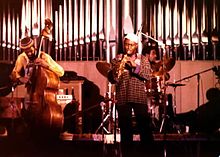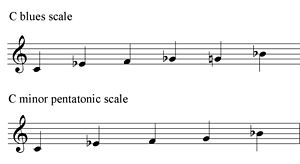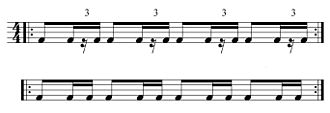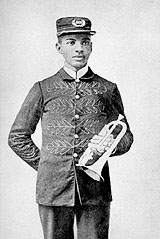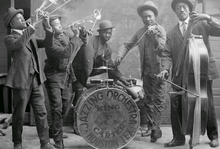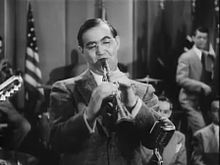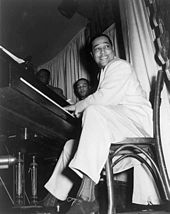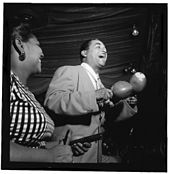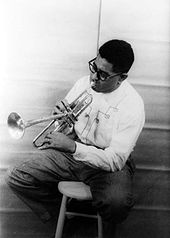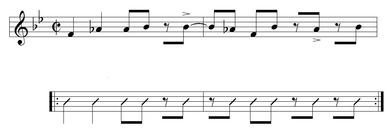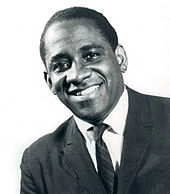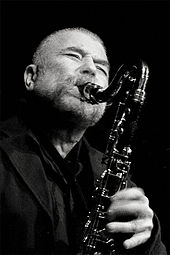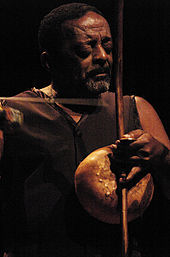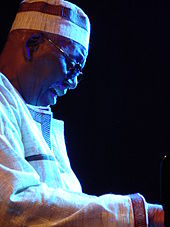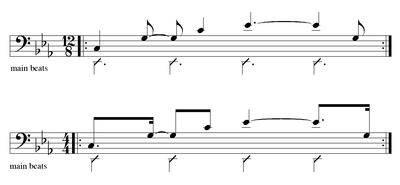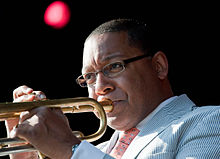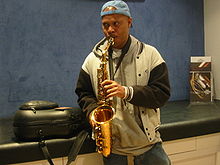
Jazz
About this schools Wikipedia selection
This Wikipedia selection is available offline from SOS Children for distribution in the developing world. Visit the SOS Children website at http://www.soschildren.org/
| Jazz | |
|---|---|
| Stylistic origins: | |
| Cultural origins: | Early 1910s New Orleans |
| Typical instruments: | |
| Mainstream popularity: | 1920s–1970s |
| Derivatives: |
|
| Subgenres | |
|
|
| Fusion genres | |
|
|
| Regional scenes | |
|
|
| Local scenes | |
|
|
| Jazz musicians | |
|
|
| Other topics | |
|
|
Jazz is a music that originated at the beginning of the 20th century within the African-American communities of the Southern United States. Its roots lie in the African-American adoption of European harmony and form to existing African musical elements. African musical influences are evident in the use of blue notes, improvisation, polyrhythms, syncopation and the swung note. From its early development until the present day, jazz has also incorporated elements from American popular music.
As the music has developed and spread around the world it has drawn on many different national, regional, and local musical cultures giving rise, since its early 20th century American beginnings, to many distinctive styles: New Orleans jazz dating from the early 1910s; big band swing, Kansas City jazz, and Gypsy jazz from the 1930s and 1940s; bebop from the mid-1940s; and on down through West Coast jazz, cool jazz, avant-garde jazz, Afro-Cuban jazz, modal jazz, free jazz, Latin jazz in various forms, soul jazz, jazz fusion, and jazz rock, smooth jazz, jazz-funk, punk jazz, acid jazz, ethno jazz, jazz rap, cyber jazz, Indo jazz, M-Base, nu jazz, and other ways of playing the music.
In a 1988 interview, trombonist J. J. Johnson said, "Jazz is restless. It won't stay put and it never will".
Definitions
Jazz spans a range of music from ragtime to the present day—a period of over 100 years—and has proved to be very difficult to define. Attempts have been made to define jazz from the perspective of other musical traditions—using the point of view of European music history or African music for example—but critic Joachim Berendt argues that its terms of reference and its definition should be broader. Berendt defines jazz as a "form of art music which originated in the United States through the confrontation of blacks with European music" and argues that it differs from European music in that jazz: has a "special relationship to time, defined as ' swing'"; involves "a spontaneity and vitality of musical production in which improvisation plays a role"; and contains a "sonority and manner of phrasing which mirror the individuality of the performing jazz musician".
A broader definition that encompasses all of the radically different eras of jazz has been proposed by Travis Jackson: he states that it is music that includes qualities such as swing, improvising, group interaction, developing an 'individual voice', and being open to different musical possibilities. An overview of the discussion on definitions is provided by Krin Gabbard, who argues that "jazz is a construct" that, while artificial, still is useful to designate "a number of musics with enough in common to be understood as part of a coherent tradition". In contrast to the efforts of commentators and enthusiasts of certain types of jazz, who have argued for narrower definitions that exclude other types, the musicians themselves are often reluctant to define the music they play. Duke Ellington summed up this perspective by saying, "It's all music".
Importance of improvisation
While jazz is considered difficult to define, improvisation is consistently regarded as being one of its key elements. The centrality of improvisation in jazz is attributed to its presence in influential earlier forms of music: the early blues, a form of folk music which arose in part from the work songs and field hollers of the African-American workers on plantations. These were commonly structured around a repetitive call-and-response pattern, but early blues was also highly improvisational. Although European classical music has been said to be a composer's medium in which the performer is sometimes granted discretion over interpretation, ornamentation and accompaniment, the performer's primary goal is to play a composition as it was written. In contrast, jazz is often characterized as the product of group creativity, interaction, and collaboration, that places varying degrees of value on the contributions of composer (if there is one) and performers. Summarizing the difference, pianist Earl Hines remarked in a 1975 film that,
... when I was playing classical music I wouldn't dare get away from what I was reading. If you've noticed, all of the symphonic musicians, they have played some of those classical tunes for years but they wouldn't vary from one note—and every time they play they have to have the music. So that's why for some classical musicians, it's very difficult for them to try to learn how to play jazz.
In jazz, therefore, the skilled performer will interpret a tune in very individual ways, never playing the same composition exactly the same way twice. Depending upon the performer's mood and personal experience, interactions with other musicians, or even members of the audience, a jazz musician may alter melodies, harmonies or time signature at will. The importance of improvisation has led some critics to suggest that even Duke Ellington's music was not jazz, because it was arranged and orchestrated. On the other hand, the solo piano "transformative versions" of Ellington compositions by Earl Hines were described by Ben Ratliff, the New York Times jazz critic, as being "as good an example of the jazz process as anything out there".
The approach to improvisation has developed enormously over the history of the music. In early New Orleans and Dixieland jazz, performers took turns playing the melody, while others improvised countermelodies. By the swing era, big bands were coming to rely more on arranged music: arrangements were either written or learned by ear and memorized, while individual soloists would improvise within these arrangements. Later, in bebop the focus shifted back towards small groups and minimal arrangements; the melody (known as the "head") would be stated briefly at the start and end of a piece, but the core of the performance would be the series of improvisations. Later styles such as modal jazz abandoned the strict notion of a chord progression, allowing the individual musicians to improvise even more freely within the context of a given scale or mode. In many forms of jazz a soloist is often supported by a rhythm section that accompanies the soloist by playing chords and rhythms that outline the song structure and complement the soloist. In avant-garde and free jazz idioms, the separation of soloist and band is reduced, and there is license, or even a requirement, for the abandoning of chords, scales, and rhythmic meters.
Debates
Forms of jazz that are commercially oriented or influenced by popular music have been criticized since at least the emergence of bebop. According to Bruce Johnson, there has always been a "tension between jazz as a commercial music and an art form". Traditional jazz enthusiasts have dismissed bebop, free jazz, the 1970s jazz fusion era, and much else as periods of debasement of the music and betrayals of the tradition; the alternative viewpoint is that jazz is able to absorb and transform influences from diverse musical styles, and that, by avoiding the creation of 'norms', other newer, avant-garde forms of jazz will be free to emerge.
Another debate that gained a lot of attention at the birth of jazz was how it would affect the appearance of African-Americans, in particular, who were a part of it. To some African-Americans, jazz has highlighted their contribution to American society and helped bring attention to black history and culture, but for others, the music and term 'jazz' are reminders of "an oppressive and racist society and restrictions on their artistic visions".
Etymology of "jazz"
The origin of the word jazz has had wide spread interest—the American Dialect Society named it the Word of the Twentieth Century—which has resulted in considerable research, and its history is well documented. The word began [under various spellings] as West Coast slang around 1912, the meaning of which varied but did not refer to music. The use of the word in a musical context was documented as early as 1915 in the Chicago Daily Tribune. Its first documented use in a musical context in New Orleans appears in a November 14, 1916 Times-Picayune article about "jas bands."
Origins
Blending European and African music sensibilities
By 1808 the Atlantic slave trade had brought almost half a million Sub-Saharan Africans to the United States. The slaves largely came from West Africa and the greater Congo River basin. They brought strong musical traditions with them. The rhythms had a counter-metric structure, and reflected African speech patterns. African music was largely functional, for work or ritual. The African traditions made use of a single-line melody and call-and-response pattern, but without the European concept of harmony.
Slave gatherings
Lavish festivals featuring African-based dances to drums were organized on Sundays at Place Congo, or Congo Square, in New Orleans until 1843. There are historical accounts of other music and dance gatherings elsewhere in the southern United States. Robert Palmer states:
An exhaustive analysis of diaries, letters, and travelers' journals from colonial times up to the Civil War, undertaken by Dena J. Epstein and detailed in her book Sinful Tunes and Spirituals [1977], yielded a surprising number of references to slave music that was primarily percussive. Usually such music was associated with annual festivals, when the year's crop was harvested and several days were set aside for celebration. As late as 1861, a traveler in North Carolina saw dancers dressed in costumes that included horned headdresses and cow tails and heard music provided by a sheepskin-covered "gumbo box", apparently a frame drum; triangles and jawbones furnished the auxiliary percussion. There are quite a few [accounts] from the southeastern states and Louisiana dating from the period 1820–1850. Some of the earliest [Mississippi] Delta settlers came from the vicinity of New Orleans, where drumming was never actively discouraged for very long and homemade drums were used to accompany public dancing until the outbreak of the Civil War.
The Black church
Another influence came from black slaves who had learned the harmonic style of hymns of the church, and incorporated it into their own music as spirituals. The origins of the blues are undocumented, though they can be seen as the secular counterpart of the spirituals. However, as Gerhard Kubik points out, whereas the spirituals are homophonic, rural blues and early jazz "was largely based on concepts of heterophony."
Minstrel and salon music
In the early 19th century an increasing number of black musicians learned to play European instruments, particularly the violin, which they used to parody European dance music in their own cakewalk dances. In turn, European-American minstrel show performers in blackface popularized such music internationally, combining syncopation with European harmonic accompaniment. Paul Oliver has drawn attention to similarities in instruments, music and social function to the griots of Africa's western Sudanic belt. In the mid-1800s the white New Orleans composer Louis Moreau Gottschalk adapted slave rhythms and melodies from Cuba and other Caribbean islands, into piano salon music. New Orleans was the main nexus between the Afro-Caribbean and African American cultures.
African rhythmic retention
In the opinion of jazz historian Ernest Borneman, what preceded New Orleans jazz before 1890, was "Afro-Latin music" similar to what was played in the Caribbean at the time. A fundamental rhythmic figure heard in Gottschalk's compositions such as "Souvenirs From Havana" (1859), many different slave musics of the Caribbean, as well as the bamboula, and other Afro-Caribbean folk dances performed in New Orleans Congo Square, is the three-stroke pattern known in Cuban music as tresillo. Tresillo is the most basic and by far, the most prevalent duple-pulse rhythmic cell in sub-Saharan African music traditions, and the music of the African Diaspora.
The " Black Codes" outlawed drumming by slaves. Therefore, unlike in Cuba, Haiti, and elsewhere in the Caribbean, African drumming traditions were not preserved in North America. African-based rhythmic patterns were retained in the United States in large part, through "body rhythms" such as stomping, clapping, and patting juba. Robert Palmer states: "The patting, an ex-slave reported in 1853, 'is performed by striking the right shoulder with one hand, the left hand with the other—all while keeping time with the feet, and singing.'" African Americans also used everyday household items as percussion instruments. Anthropologist David Evans did extensive fieldwork in the hill country of northern Mississippi, and reports of black families playing polyrhythmic music in their homes on chairs, tin cans, and empty bottles.
There are examples of tresillo, or tresillo-like rhythms in a few surviving nineteenth century African American folk musics, such as patting juba, and the clapping and foot stomping patterns in ring shout. Palmer describes the foot-generated music:
Accounts ... leave little doubt that the dancing and stamping constituted a kind of drumming, especially when the worshippers had a wooden church floor to stamp on. "It always rouses my imagination," wrote Lydia Parrish of the Georgia Sea Islands in 1942, "to see the way in which the McIntosh County 'shouters' tap their heels on the resonant floor to imitate the beat of the drum their forebears were not allowed to have." See: The Ringshout and the Birth of African-American Religion
Two decades after drumming was banned in Congo Square, in the post-Civil War period (after 1865), African Americans were able to obtain surplus military bass drums, snare drums and fifes. As a result, an original African American drum and fife music arose, featuring tresillo and related syncopated rhythmic figures. With this music genre, we see the emergence of a drumming tradition that is distinct from its Caribbean counterparts, expressing a sensibility that is uniquely African American. Evans states that among the older black drum and fife musicians of northern Mississippi, making the drums "talk it"—that is, playing rhythm patterns that conform to proverbial phrases or the words of popular fife and drum tunes—"is considered the sign of a good drummer." Palmer observes: "The snare and bass drummers played syncopated cross-rhythms," and speculates—"this tradition must have dated back to the latter half of the nineteenth century, and it could have not have developed in the first place if there hadn't been a reservoir of polyrhythmic sophistication in the culture it nurtured." See: African-American Fife & Drum Music: Mississippi.
Tresillo is heard prominently in New Orleans second line music, and in most every other form of popular music to come out of that city from the turn of the twentieth century to present. Jazz historian Gunther Schuller states:
It is probably safe to say that by and large the simpler African rhythmic patterns survived in jazz ... because they could be adapted more readily to European rhythmic conceptions. Some survived, others were discarded as the Europeanization progressed. It may also account for the fact that patterns such as [tresillo have] ... remained one of the most useful and common syncopated patterns in jazz (1968: 19).
"Spanish tinge"—the Afro-Cuban rhythmic influence
African American music began incorporating Afro-Cuban rhythmic motifs in the nineteenth century, when the habanera (Cuban contradanza) gained international popularity. Habaneras were widely available as sheet music. The habanera was the first written music to be rhythmically based on an African motif (1803). From the perspective of African American music, the habanera rhythm (also known as congo, tango-congo, or tango.) can be thought of as a combination of tresillo and the backbeat.
Musicians from Havana and New Orleans would take the twice-daily ferry between both cities to perform and not surprisingly, the habanera quickly took root in the musically fertile Crescent City. The habanera was the first of many Cuban music genres which enjoyed periods of popularity in the United States, and reinforced and inspired the use of tresillo-based rhythms in African American music.
John Storm Roberts states that the musical genre habanera, "reached the U.S. twenty years before the first rag was published." The piano piece "Ojos Criollos (Danse Cubaine)" (1860) by New Orleans native Louis Moreau Gottschalk, was influenced by the composer's studies in Cuba. The habanera rhythm is clearly heard in the left hand. With Gottschalk's symphonic work "A Night in the Tropics" (1859), we hear the tresillo variant cinquillo extensively. The figure was also used by Scott Joplin and other ragtime composers.
For the more than quarter-century in which the cakewalk, ragtime, and proto-jazz were forming and developing, the habanera was a consistent part of African American popular music. Comparing the music of New Orleans with the music of Cuba, Wynton Marsalis observes that tresillo is the New Orleans " clave", a Spanish word meaning 'code,' or 'key'—as in the key to a puzzle, or mystery. Although technically, the pattern is only half a clave, Marsalis makes the important point that the single-celled figure is the guide-pattern of New Orleans music. Jelly Roll Morton called the rhythmic figure the Spanish tinge, and considered it an essential ingredient of jazz.
1890s–1910s
Ragtime
The abolition of slavery led to new opportunities for the education of freed African Americans. Although strict segregation limited employment opportunities for most blacks, many were able to find work in entertainment. Black musicians were able to provide "low-class" entertainment in dances, minstrel shows, and in vaudeville, by which many marching bands formed. Black pianists played in bars, clubs, and brothels, as ragtime developed.
Ragtime appeared as sheet music, popularized by African American musicians such as the entertainer Ernest Hogan, whose hit songs appeared in 1895; two years later Vess Ossman recorded a medley of these songs as a banjo solo "Rag Time Medley". Also in 1897, the white composer William H. Krell published his " Mississippi Rag" as the first written piano instrumental ragtime piece, and Tom Turpin published his Harlem Rag, that was the first rag published by an African-American.
The classically trained pianist Scott Joplin and the acknowledged "king of ragtime" produced his " Original Rags" in the following year, then in 1899 had an international hit with " Maple Leaf Rag". "Maple Leaf Rag" is a multi- strain ragtime march with athletic bass lines and offbeat melodies. Each of the four parts features a recurring theme and a striding bass line with copious seventh chords. The piece may be considered the 'archetypal rag' due to its influence on the genre; its structure was the basis for many other famous rags, including "Sensation" by Joseph Lamb. It is more carefully constructed than almost all the previous rags, and the syncopations in the right hand, especially in the transition between the first and second strain, were novel at the time.
African-based rhythmic patterns, such as tresillo, and its variants—the habanera rhythm and cinquillo, are heard in the ragtime compositions of Scott Joplin, Tom Turpin, and others. Joplin's "Solace" (1909) is generally considered to be within the habanera genre (although it's labeled a "Mexican serenade"). The following excerpt from "Solace" is based on two different variants of the habanera rhythm.
With "Solace" both hands are playing in a syncopated fashion, completely abandoning any sense of a march rhythm. Ned Sublette postulates that the tresillo/habanera rhythm "found its way into ragtime and the cakewalk," while Roberts suggests that "the habanera influence may have been part of what freed black music from ragtime's European bass."
Joplin wrote numerous popular rags, including " The Entertainer", combining right hand tresillo-based syncopation, banjo figurations and sometimes call-and-response. The ragtime idiom was eventually taken up by classical composers including Claude Debussy and Igor Stravinsky.
Blues
African genesis
Blues is the name given to both a musical form and a music genre that originated in African-American communities of primarily the " Deep South" of the United States at the end of the 19th century from spirituals, work songs, field hollers, shouts and chants, and rhymed simple narrative ballads. The African use of pentatonic scales contributed to the development of blue notes in blues and jazz. As Kubik explains:
Many of the rural blues of the Deep South are stylistically an extension and merger of basically two broad accompanied song-style traditions in the west central Sudanic belt:
- A strongly Arabic/Islamic song style, as found for example among the Hausa. It is characterized by melisma, wavy intonation, pitch instabilities within a pentatonic framework, and a declamatory voice.
- An ancient west central Sudanic stratum of pentatonic song composition, often associated with simple work rhythms in a regular meter, but with notable off-beat accents (1999: 94).
Within the context of Western harmony
In 1892 St. Louis, Missouri, W.C. Handy, an out of work African American cornet player, with experience in minstrel shows and brass bands, encountered his first blues (or proto-blues) song. It had numerous one-line verses "and they would sing it all night." In 1912, Handy published what he heard that night as " St. Louis Blues." In 1903, while traveling through the Mississippi Delta, Handy experienced a form of blues with more pronounced African traits. The Delta blues style intrigued him. The singer improvised freely, and the melodic range was limited, sounding like a field holler. The guitar accompaniment was not strummed, but was instead, like a small drum that responded in syncopated accents. The guitar was another "voice." Handy's " St. Louis Blues" and " Memphis Blues" (1912) are jazz standards. While many identify Handy's "Memphis Blues" as the first published blues, Gunther Schuller argues that it is not really a blues, but "more like a cakewalk."
The blues form, ubiquitous in jazz, is characterized by specific chord progressions, of which the twelve-bar blues chord progression is the most common. The blue notes that, for expressive purposes are sung or played flattened or gradually bent (minor 3rd to major 3rd) in relation to the pitch of the major scale, are also an important part of the sound. The blues were the key that opened up an entirely new approach to Western harmony, ultimately leading to a high level of harmonic complexity in jazz.
New Orleans
The music of New Orleans had a profound effect on the creation of early jazz. Many early jazz performers played in venues throughout the city; the brothels and bars of the red-light district around Basin Street, called " Storyville". was only one of numerous neighborhoods relevant to the early days of New Orleans jazz. In addition to dance bands, numerous marching bands played at lavish funerals arranged by the African American and European American community. The instruments used in marching bands and dance bands became the basic instruments of jazz: brass and reeds tuned in the European 12-tone scale and drums. Small bands mixing self-taught and well educated African American musicians, many of whom came from the funeral-procession tradition of New Orleans, played a seminal role in the development and dissemination of early jazz, traveling throughout Black communities in the Deep South and, from around 1914 on, Afro-Creole and African American musicians playing in vaudeville shows took jazz to western and northern US cities.
Syncopation
The cornetist Buddy Bolden led a band often mentioned as one of the prime movers of the style later to be called "jazz". He played in New Orleans around 1895–1906. Bolden's band is credited with creating the big four, the first syncopated bass drum pattern to deviate from the standard on-the-beat march. As the example below shows, the second half of the big four pattern is the habanera rhythm.
No recordings remain of Bolden. Several tunes from the Bolden band repertory, including "Buddy Bolden Blues", have been recorded by many other musicians. Bolden became mentally ill and spent his later decades in a mental institution.
Afro-Creole pianist Jelly Roll Morton began his career in Storyville. From 1904, he toured with vaudeville shows around southern cities, also playing in Chicago and New York. His " Jelly Roll Blues", which he composed around 1905, was published in 1915 as the first jazz arrangement in print, introducing more musicians to the New Orleans style.
Morton would perform habaneras, such as " La Paloma." He considered the tresillo/habanera (which he called the Spanish tinge) to be an essential ingredient of jazz. The habanera rhythm and tresillo can be heard in his left hand on songs like "The Crave" (1910, recorded 1938). In Morton's own words:
"Now in one of my earliest tunes, "New Orleans Blues," you can notice the Spanish tinge. In fact, if you can’t manage to put tinges of Spanish in your tunes, you will never be able to get the right seasoning, I call it, for jazz"—Morton (1938: Library of Congress Recording).
Some early jazz musicians referred to their music as ragtime. Jelly Roll Morton was a crucial innovator in the evolution from ragtime to jazz piano. Morton could perform pieces in either style. Morton's solos were still close to ragtime, and were not merely improvisations over chord changes, as with later jazz. His use of the blues was of equal importance however.
Swing
Morton loosened ragtime's rhythmic feeling, decreasing its embellishments, and employing a swing feeling. Swing is the most important, and enduring African-based rhythmic technique used in jazz. An oft quoted definition of swing by Louis Armstrong is: "if you don't feel it, you'll never know it." The New Harvard Dictionary of Music states that swing is: “An intangible rhythmic momentum in jazz . . . Swing defies analysis; claims to its presence may inspire arguments." However, the dictionary does provide the useful description of triple subdivisions of the beat contrasted with duple subdivisions. Swing superimposes six subdivisions of the beat over a basic pulse structure or four subdivisions. This aspect of swing is far more prevalent in African American music than in Afro-Caribbean music. One aspect of swing, which is heard in more rhythmically complex Diaspora musics, places strokes in-between the triple and duple-pulse “grids.”
New Orleans brass bands are a lasting influence contributing horn players to the world of professional jazz with the distinct sound of the city while helping black children escape poverty. The leader of the Camelia Brass Band, D'Jalma Ganier, taught Louis Armstrong to play trumpet. Armstrong popularized the New Orleans style of trumpet playing, and then expanded it. Like Jelly Roll Morton, Louis Armstrong is also credited with the abandonment of ragtime's stiffness, in favour of swung notes. Armstrong, perhaps more than any other musician, codified the rhythmic technique of swing in jazz, and broadened the jazz solo vocabulary.
The Original Dixieland Jass Band made the music's first recordings early in 1917, and their " Livery Stable Blues" became the earliest released jazz record. That year numerous other bands made recordings featuring "jazz" in the title or band name, mostly ragtime or novelty records rather than jazz. In February 1918 James Reese Europe's "Hellfighters" infantry band took ragtime to Europe during World War I, then on return recorded Dixieland standards including " Darktown Strutters' Ball".
Other regions
W.C. Handy, who was from Alabama, states that when he was travelling with his band in 1896, he was playing "novelty music ... similar to jazz, but we didn't call it jazz." Later, in 1903, Handy became intrigued with the folk blues of the Deep South. He and his band members were formally trained African American musicians, who did not grow up with the blues. Yet, Handy was able to adopt the blues to a larger band instrument format, and arrange them in a popular music form. Handy wrote about his adopting of the blues:
"The primitive southern Negro, as he sang, was sure to bear down on the third and seventh tone of the scale, slurring between major and minor. Whether in the cotton field of the Delta or on the Levee up St. Louis way, it was always the same. Till then, however, I had never heard this slur used by a more sophisticated Negro, or by any white man. I tried to convey this effect ... by introducing flat thirds and sevenths (now called blue notes) into my song, although its prevailing key was major ..., and I carried this device into my melody as well ... This was a distinct departure, but as it turned out, it touched the spot."
The 1912 publication of his "Memphis Blues" sheet music introduced the 12-bar blues to the world. Handy's autobiography is titled Father of the Blues. Like Morton, Handy's music career began in the pre-jazz era, and contributed to the codification of jazz, through the publication of some of the first jazz sheet music. In September 1917 Handy's Orchestra of Memphis recorded a cover version of "Livery Stable Blues."
Also like Morton, Handy performed habaneras. Handy noted a reaction to the habanera rhythm included in Will H. Tyler's "Maori"—"I observed that there was a sudden, proud and graceful reaction to the rhythm ... White dancers, as I had observed them, took the number in stride. I began to suspect that there was something Negroid in that beat." After noting a similar reaction to the same rhythm in "La Paloma", Handy included this rhythm in his " St. Louis Blues" (1914).
In addition, Handy used the habanera rhythm in the instrumental copy of "Memphis Blues", the chorus of "Beale Street Blues", and other compositions."
In the northeastern United States, a "hot" style of playing ragtime had developed, notably James Reese Europe's symphonic Clef Club orchestra in New York which played a benefit concert at Carnegie Hall in 1912. The Baltimore rag style of Eubie Blake influenced James P. Johnson's development of " Stride" piano playing, in which the right hand plays the melody, while the left hand provides the rhythm and bassline.
In Ohio and elsewhere in the midwest, ragtime was the major influence until about 1919. Around 1912, when the four-string banjo and saxophone came in, the musicians began to improvise the melody line, but the harmony and rhythm remained unchanged. A contemporary account states that blues could only be heard in jazz, in the gut-bucket cabarets, which were generally looked down upon by the Black middle-class.
1920s and 1930s
The Jazz Age
 |
Jazz Me Blues
The Original Dixieland Jass Band performing "Jazz Me Blues", an example of a jazz piece from 1921.
|
| Problems listening to this file? See media help. | |

Prohibition in the United States (from 1920 to 1933) banned the sale of alcoholic drinks, resulting in illicit speakeasies becoming lively venues of the "Jazz Age", an era when popular music included current dance songs, novelty songs, and show tunes. Jazz started to get a reputation as being immoral and many members of the older generations saw it as threatening the old values in culture and promoting the new decadent values of the Roaring 20s. Professor Henry van Dyke of Princeton University wrote "... it is not music at all. It's merely an irritation of the nerves of hearing, a sensual teasing of the strings of physical passion."
Even the media began to denigrate jazz. The New York Times took stories and altered headlines to pick at jazz. For instance, villagers used pots and pans in Siberia to scare off bears, and the newspaper stated that it was jazz that scared the bears away. Another story claims that Jazz caused the death of a celebrated conductor. The actual cause of death was a fatal heart attack (natural cause).
From 1919 Kid Ory's Original Creole Jazz Band of musicians from New Orleans played in San Francisco and Los Angeles where in 1922 they became the first black jazz band of New Orleans origin to make recordings. However, the main centre developing the new " Hot Jazz" was Chicago, where King Oliver joined Bill Johnson. That year also saw the first recording by Bessie Smith, the most famous of the 1920s blues singers. Bix Beiderbecke formed The Wolverines in 1924.
Also in 1924 Louis Armstrong joined the Fletcher Henderson dance band as featured soloist for a year. The original New Orleans style was polyphonic, with theme variation, and simultaneous collective improvisation. Armstrong was a master of his hometown style, but by the time he joined Henderson's band, he was already a trailblazer in a new phase of jazz, with its emphasis on arrangements and soloists. Armstrong's solos went well beyond the theme-improvisation concept, and extemporized on chords, rather than melodies. According to Schuller, by comparison, the solos by Armstrong's bandmates (including a young Coleman Hawkins), sounded "stiff, stodgy," with "jerky rhythms and a grey undistinguished tone quality." The following example shows a short excerpt of the straight melody of "Mandy, Make Up Your Mind" by Irving Berlin (top), compared with Louis Armstrong's solo improvisations (below) (recorded 1924). The example approximates Armstrong's solo, as it doesn't convey his use of swing.
Armstrong's solos were a significant factor in making jazz a true twentieth-century language. After leaving Henderson's group, Armstrong formed his virtuosic Hot Five band, where he popularized scat singing.
Jelly Roll Morton recorded with the New Orleans Rhythm Kings in an early mixed-race collaboration, then in 1926 formed his Red Hot Peppers. There was a larger market for jazzy dance music played by white orchestras, such as Jean Goldkette's orchestra and Paul Whiteman's orchestra. In 1924 Whiteman commissioned Gershwin's Rhapsody in Blue, which was premiered by Whiteman's Orchestra. Other influential large ensembles included Fletcher Henderson's band, Duke Ellington's band (which opened an influential residency at the Cotton Club in 1927) in New York, and Earl Hines's Band in Chicago (who opened in The Grand Terrace Cafe there in 1928). All significantly influenced the development of big band-style swing jazz. By 1930, the New Orleans-style ensemble was a relic, and jazz belonged to the world.
Swing
The 1930s belonged to popular swing big bands, in which some virtuoso soloists became as famous as the band leaders. Key figures in developing the "big" jazz band included bandleaders and arrangers Count Basie, Cab Calloway, Jimmy and Tommy Dorsey, Duke Ellington, Benny Goodman, Fletcher Henderson, Earl Hines, Glenn Miller and Artie Shaw.
Swing was also dance music. It was broadcast on the radio 'live' nightly across America for many years especially by Hines and his Grand Terrace Cafe Orchestra broadcasting coast-to-coast from Chicago, well placed for 'live' time-zones. Although it was a collective sound, swing also offered individual musicians a chance to 'solo' and improvise melodic, thematic solos which could at times be very complex and 'important' music.
Over time, social strictures regarding racial segregation began to relax in America: white bandleaders began to recruit black musicians and black bandleaders white ones.
In the mid-1930s, Benny Goodman hired pianist Teddy Wilson, vibraphonist Lionel Hampton and guitarist Charlie Christian to join small groups. An early 1940s style known as "jumping the blues" or jump blues used small combos, uptempo music, and blues chord progressions. Jump blues drew on boogie-woogie from the 1930s. Kansas City Jazz in the 1930s as exemplified by tenor saxophonist Lester Young marked the transition from big bands to the bebop influence of the 1940s.
Beginnings of European jazz
Outside of the United States the beginnings of a distinct European style of jazz emerged in France with the Quintette du Hot Club de France, which began in 1934. Belgian guitar virtuoso Django Reinhardt popularized gypsy jazz, a mix of 1930s American swing, French dance hall " musette" and Eastern European folk with a languid, seductive feel. The main instruments are steel stringed guitar, violin, and double bass. Solos pass from one player to another as the guitar and bass play the role of the rhythm section. Some music researchers hold that it was Philadelphia's Eddie Lang and Joe Venuti who pioneered the guitar-violin partnership typical of the genre, which was brought to France after they had been heard live or on Okeh Records in the late 1920s.
1940s and 1950s
"American music"—the genius of Ellington
By the 1940s, Duke Ellington's music transcended the bounds of swing, bridging jazz and art music in a natural synthesis. Ellington called his music "American Music" rather than jazz, and liked to describe those who impressed him as "beyond category." These included many of the musicians who were members of his orchestra, some of whom are considered among the best in jazz in their own right, but it was Ellington who melded them into one of the most well-known jazz orchestral units in the history of jazz. He often composed specifically for the style and skills of these individuals, such as "Jeep's Blues" for Johnny Hodges, "Concerto for Cootie" for Cootie Williams, which later became " Do Nothing Till You Hear from Me" with Bob Russell's lyrics, and "The Mooche" for Tricky Sam Nanton and Bubber Miley. He also recorded songs written by his bandsmen, such as Juan Tizol's " Caravan" and " Perdido" which brought the " Spanish Tinge" to big-band jazz. Several members of the orchestra remained there for several decades. The band reached a creative peak in the early 1940s, when Ellington and a small hand-picked group of his composers and arrangers wrote for an orchestra of distinctive voices who displayed tremendous creativity.
Bebop
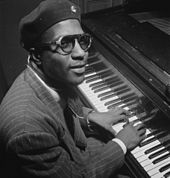
In the early 1940s bebop-style performers began to shift jazz from danceable popular music towards a more challenging "musician's music." The most influential bebop musicians included saxophonist Charlie Parker, pianists Bud Powell and Thelonious Monk, trumpeters Dizzy Gillespie and Clifford Brown, and drummer Max Roach. Composer Gunther Schuller wrote:
... In 1943 I heard the great Earl Hines band which had Bird in it and all those other great musicians. They were playing all the flatted fifth chords and all the modern harmonies and substitutions and Dizzy Gillespie runs in the trumpet section work. Two years later I read that that was 'bop' and the beginning of modern jazz ... but the band never made recordings.
Divorcing itself from dance music, bebop established itself more as an art form, thus lessening its potential popular and commercial appeal. Dizzy Gillespie wrote:
... People talk about the Hines band being 'the incubator of bop' and the leading exponents of that music ended up in the Hines band. But people also have the erroneous impression that the music was new. It was not. The music evolved from what went before. It was the same basic music. The difference was in how you got from here to here to here ... naturally each age has got its own shit.
Rhythm
Since bebop was meant to be listened to, not danced to, it could use faster tempos. Drumming shifted to a more elusive and explosive style, in which the ride cymbal was used to keep time while the snare and bass drum were used for accents. This led to a highly syncopated, linear rhythmic complexity.
Harmony
Bebop musicians employed several harmonic devices not typical of previous jazz, engaging in a more abstracted form of chord-based improvisation. Bebop scales are traditional scales, with an added chromatic passing note. Bebop also uses "passing" chords, substitute chords, and altered chords. New forms of chromaticism and dissonance were introduced into jazz; the dissonant tritone (or "flatted fifth") interval became the "most important interval of bebop" Chord progressions for bebop tunes were often taken directly from popular swing-era songs and reused with a new and more complex melody, forming new compositions. This practice was already well-established in earlier jazz, but came to be central to the bebop style. Bebop made use of several relatively common chord progressions, such as blues (at base, I-IV-V, but infused with II-V motion) and 'rhythm changes' (I-VI-II-V, the chords to the 1930s pop standard " I Got Rhythm." Late bop also moved towards extended forms that represented a departure from pop and show tunes. The harmonic development in bebop, is often traced back to a transcendent moment experienced by Charlie Parker while performing "Cherokee" at Clark Monroe's Uptown House, New York, in early 1942.
I'd been getting bored with the stereotyped changes that were being used, ... and I kept thinking there's bound to be something else. I could hear it sometimes. I couldn't play it.... I was working over ‘Cherokee,’ and, as I did, I found that by using the higher intervals of a chord as a melody line and backing them with appropriately related changes, I could play the thing I'd been hearing. It came alive—Parker.
Gerhard Kubik postulates that the harmonic development in bebop sprang from the blues, and other African-related tonal sensibilities, rather than twentieth century Western art music, as some have suggested. Kubik states: "Auditory inclinations were the African legacy in [Parker's] life, reconfirmed by the experience of the blues tonal system, a sound world at odds with the Western diatonic chord categories. Bebop musicians eliminated Western-style functional harmony in their music while retaining the strong central tonality of the blues as a basis for drawing upon various African matrices." Samuel Floyd states that blues were both the bedrock and propelling force of bebop, bringing about three main developments:
- A new harmonic conception, using extended chord structures that led to unprecedented harmonic and melodic variety.
- A developed and even more highly syncopated, linear rhythmic complexity and a melodic angularity in which the blue note of the fifth degree was established as an important melodic-harmonic device.
- The reestablishment of the blues as the music's primary organizing and functional principle.
While for an outside observer, the harmonic innovations in bebop would appear to be inspired by experiences in Western "serious" music, from Claude Debussy to Arnold Schoenberg, such a scheme cannot be sustained by the evidence from a cognitive approach. Claude Debussy did have some influence on jazz, for example, on Bix Beiderbecke's piano playing. And it is also true that Duke Ellington adopted and reinterpreted some harmonic devices in European contemporary music. West Coast jazz would run into such debts as would several forms of cool jazz, but bebop has hardly any such debts in the sense of direct borrowings. On the contrary, ideologically, bebop was a strong statement of rejection of any kind of eclecticism, propelled by a desire to activate something deeply buried in self. Bebop then revived tonal-harmonic ideas transmitted through the blues and reconstructed and expanded others in a basically non-Western harmonic approach. The ultimate significance of all this is that the experiments in jazz during the 1940s brought back to African-American music several structural principles and techniques rooted in African traditions—Kubik (2005).
These divergences from the jazz mainstream of the time initially met with a divided, sometimes hostile, response among fans and fellow musicians, especially established swing players, who bristled at the new harmonic sounds. To hostile critics, bebop seemed to be filled with "racing, nervous phrases". Despite the initial friction, by the 1950s bebop had become an accepted part of the jazz vocabulary.
Afro-Cuban jazz (cu-bop)
Machito and Mario Bauza
The general consensus among musicians and musicologists is that the first original jazz piece to be overtly based in-clave was "Tanga" (1943), composed by Cuban-born Mario Bauza and recorded by Machito and his Afro-Cubans in New York City. "Tanga" began as a spontaneous descarga (Cuban jam session) with jazz solos superimposed on top.
This was the birth of Afro-Cuban jazz. The use of clave brought the African timeline, or key pattern, into jazz. Music organized around key patterns convey a two-celled (binary) structure, which is a complex level of African cross-rhythm. Within the context of jazz however, harmony is the primary referent, not rhythm. The harmonic progression can begin on either side of clave, and the harmonic "one" is always understood to be "one". If the progression begins on the "three-side" of clave, it is said to be in 3-2 clave. If the progression begins on the "two-side", its in 2-3 clave.
Bobby Sanabria mentions several innovations of Machito's Afro-Cubans; they were the first band to: wed big band jazz arranging techniques within an original composition, with jazz oriented soloists utilizing an authentic Afro-Cuban based rhythm section in a successful manner; explore modal harmony (a concept explored much later by Miles Davis and Gil Evans) from a jazz arranging perspective; and to overtly explore the concept of clave conterpoint from an arranging standpoint (the ability to weave seamlessly from one side of the clave to the other without breaking its rhythmic integrity within the structure of a musical arrangement). They were also the first band in the United States to publicly utilize the term Afro-Cuban as the band's moniker, thus identifying itself and acknowledging the West African roots of the musical form they were playing. It forced New York City's Latino and African American communities to deal with their common West African musical roots in a direct way, whether they wanted to acknowledge it publicly or not.
Dizzy Gillespie and Chano Pozo
Mario Bauzá introduced bebop innovator Dizzy Gillespie to the Cuban conga drummer, dancer, composer, and choreographer Chano Pozo. The brief collaboration of Gillespie and Pozo produced some of the most enduring Afro-Cuban jazz standards. " Manteca" (1947), co-written by Gillespie and Pozo, is the first jazz standard to be rhythmically based on clave. According to Gillespie, Pozo composed the layered, contrapuntal guajeos (Afro-Cuban ostinatos) of the A section and the introduction, while Gillespie wrote the bridge. Gillespie recounted: "If I'd let it go like [Chano] wanted it, it would have been strickly Afro-Cuban all the way. There wouldn't have been a bridge. I thought I was writing an eight-bar bridge, but after eight bars I hadn't resolved back to B-flat, so I had to keep going and ended up writing a sixteen-bar bridge." It was the bridge that gave "Manteca" a typical jazz harmonic structure, setting the piece apart from Bauza's modal "Tanga" of a few years earlier. Jazz arrangements with a "Latin" A section and a swung B section, with all choruses swung during solos, became common practice with many "Latin tunes" of the jazz standard repertoire. This approach can be heard on pre-1980 recordings of "Manteca", " A Night in Tunisia", "Tin Tin Deo", and " On Green Dolphin Street."
Gillespie's collaboration with Pozo brought specific African-based rhythms into bebop. While pushing the boundaries of harmonic improvisation, cu-bop as it was called, also drew more directly from African rhythmic structures.
The rhythm of the melody of the A section is identical to a common mambo bell pattern.
African cross-rhythm
Cuban percussionist Mongo Santamaria first recorded his composition " Afro Blue" in 1959. "Afro Blue" was the first jazz standard built upon a typical African three-against-two (3:2) cross-rhythm, or hemiola. The song begins with the bass repeatedly playing 6 cross-beats per each measure of 12/8, or 6 cross-beats per 4 main beats—6:4 (two cells of 3:2). The following example shows the original ostinato "Afro Blue" bass line. The slashed noteheads indicate the main beats (not bass notes), where you would normally tap your foot to "keep time."
When John Coltrane covered "Afro Blue" in 1963, he inverted the metric hierarchy, interpreting the tune as a 3/4 jazz waltz with duple cross-beats superimposed (2:3). Originally a Bb pentatonic blues, Coltrane expanded the harmonic structure of "Afro Blue."
Perhaps the most respected Afro-cuban jazz combo of the late 1950s was vibraphonist Cal Tjader's band. Tjader had Mongo Santamaria, Armando Peraza, and Willie Bobo on his early recording dates.
Dixieland revival
In the late 1940s there was a revival of " Dixieland" music, harkening back to the original contrapuntal New Orleans style. This was driven in large part by record company reissues of early jazz classics by the Oliver, Morton, and Armstrong bands of the 1930s. There were two types of musicians involved in the revival. One group consisted of players who had begun their careers playing in the traditional style and were returning to it or continuing what they had been playing all along. This included Bob Crosby's Bobcats, Max Kaminsky, Eddie Condon, and Wild Bill Davison. Most of this group were originally Midwesterners, although there were a small number of New Orleans musicians involved. The second group of revivalists consisted of younger musicians, such as those in the Lu Watters band. By the late 1940s, Louis Armstrong's Allstars band became a leading ensemble. Through the 1950s and 1960s, Dixieland was one of the most commercially popular jazz styles in the US, Europe, and Japan, although critics paid little attention to it.
Cool jazz
By the end of the 1940s, the nervous energy and tension of bebop was replaced with a tendency towards calm and smoothness, with the sounds of cool jazz, which favoured long, linear melodic lines. It emerged in New York City, as a result of the mixture of the styles of predominantly white jazz musicians and black bebop musicians, and it dominated jazz in the first half of the 1950s. The starting point was a series of singles on Capitol Records in 1949 and 1950 of a nonet led by trumpeter Miles Davis, collected and released first on a ten-inch and later a twelve-inch as the Birth of the Cool. Cool jazz recordings by Chet Baker, Dave Brubeck, Bill Evans, Gil Evans, Stan Getz and the Modern Jazz Quartet usually have a "lighter" sound which avoided the aggressive tempos and harmonic abstraction of bebop.
Cool jazz later became strongly identified with the West Coast jazz scene, but also had a particular resonance in Europe, especially Scandinavia, with emergence of such major figures as baritone saxophonist Lars Gullin and pianist Bengt Hallberg. The theoretical underpinnings of cool jazz were set out by the blind Chicago pianist Lennie Tristano, and its influence stretches into such later developments as Bossa nova, modal jazz, and even free jazz. List of Cool jazz and West Coast jazz musicians for further detail.
|
"Take The 'A' Train"
This 1941 sample of Duke Ellington's signature tune is an example of the swing style.
"Yardbird Suite"
Excerpt from a saxophone solo by Charlie Parker. The fast, complex rhythms and substitute chords of bebop exhibited were of pivotal importance to the formation of Jazz music.
"Mr. P.C."
This hard blues by John Coltrane is an example of hard bop, a post-bebop style which is informed by gospel music, blues and work songs.
"Birds of Fire"
This 1973 piece by the Mahavishnu Orchestra merges jazz improvisation and rock instrumentation into jazz fusion
"The Jazzstep"
This 2000 track by Courtney Pine shows how electronica and hip hop influences can be incorporated into modern jazz.
|
|
| Problems listening to these files? See media help. | |
Hard bop
Hard bop is an extension of bebop (or "bop") music that incorporates influences from rhythm and blues, gospel music, and blues, especially in the saxophone and piano playing. Hard bop was developed in the mid-1950s, partly in response to the vogue for cool jazz in the early 1950s. The hard bop style coalesced in 1953 and 1954, paralleling the rise of rhythm and blues. Miles Davis' performance of "Walkin'", at the very first Newport Jazz Festival in 1954, announced the style to the jazz world. The quintet Art Blakey and the Jazz Messengers, fronted by Blakey and featuring pianist Horace Silver and trumpeter Clifford Brown, were leaders in the hard bop movement along with Davis.
Modal jazz
Modal jazz is a development beginning in the later 1950s which takes the mode, or musical scale, as the basis of musical structure and improvisation. Previously, the goal of the soloist was to play a solo that fit into a given chord progression. However, with modal jazz, the soloist creates a melody using one or a small number of modes. The emphasis in this approach shifts from harmony to melody. Pianist Mark Levine states: "Historically, this caused a seismic shift among jazz musicians, away from thinking vertically (the chord), and towards a more horizontal approach (the scale)."
The modal theory stems from a work by George Russell. Miles Davis introduced the concept to the greater jazz world with Kind of Blue (1959), an exploration of the possibilities of modal jazz and the best selling jazz album of all time. In contrast to Davis's earlier work with the hard bop style of jazz and its complex chord progression and improvisation, the entire album was composed as a series of modal sketches, in which each performer was given a set of scales that defined the parameters of their improvisation and style. Davis recalled: "I didn't write out the music for Kind of Blue, but brought in sketches for what everybody was supposed to play because I wanted a lot of spontaneity." The track "So What" has only two chords: D-7 and E♭-7. Listen: "So What" by Miles Davis (1959).
Other innovators in this style include Jackie McLean, John Coltrane and Bill Evans, also present on Kind of Blue, as well as later musicians such as Herbie Hancock. Coltrane's modal "Impressions" is based on the same changes as Miles Davis' "So What." Watch: "Impressions" (1961) by John Coltrane, with Eric Dolphy, McCoy Tyner, Reggie Workman, and Elvin Jones.
By the 1950s, Afro-Cuban jazz had been using modes for at least a decade. This was because a lot of Afro-Cuban jazz borrowed from Cuban popular dance forms, which are structured around multiple ostinatos with only a few chords. A case in point is Mario Bauza's "Tanga" (1943), the first Afro-Cuban jazz piece. Machito's Afro-Cubans recorded modal tunes in the 1940s, featuring jazz soloists such as Howard McGhee, Brew Moore, Charlie Parker, and Flip Phillips. Listen: "Tanga" performed by Machito's Afro-Cubans. NYC c. 1940s. There is no evidence however, that Miles Davis or other mainstream jazz musicians were influenced by the use of modes in Afro-Cuban jazz, or other branches of Latin jazz. By the 1950s Latin jazz was generally considered a novelty by the mainstream, and the genre had a limited influence.
Free jazz
Free jazz and the related form of avant-garde jazz broke through into an open space of "free tonality" in which meter, beat, and formal symmetry all disappeared, and a range of World music from India, Africa, and Arabia were melded into an intense, even religiously ecstatic or orgiastic style of playing. While loosely inspired by bebop, free jazz tunes gave players much more latitude; the loose harmony and tempo was deemed controversial when this approach was first developed. The bassist Charles Mingus is also frequently associated with the avant-garde in jazz, although his compositions draw from myriad styles and genres.
The first major stirrings came in the 1950s, with the early work of Ornette Coleman and Cecil Taylor. In the 1960s, performers included Archie Shepp, Sun Ra, Albert Ayler, Pharaoh Sanders, John Coltrane, and others. In developing his late style, Coltrane was especially influenced by the dissonance of Ayler's trio with bassist Gary Peacock and drummer Sunny Murray, a rhythm section honed with Cecil Taylor as leader. Coltrane championed many younger free jazz musicians, (notably Archie Shepp), and under his influence Impulse! became a leading free jazz record label.
A series of recordings with the Classic Quartet in the first half of 1965 show John Coltrane's playing becoming increasingly abstract, with greater incorporation of devices like multiphonics, utilization of overtones, and playing in the altissimo register, as well as a mutated return to Coltrane's sheets of sound. In the studio, he all but abandoned his soprano to concentrate on the tenor saxophone. In addition, the quartet responded to the leader by playing with increasing freedom. The group's evolution can be traced through the recordings The John Coltrane Quartet Plays, Living Space, Transition (both June 1965), New Thing at Newport (July 1965), Sun Ship (August 1965), and First Meditations (September 1965).
In June 1965, Coltrane and ten other musicians recorded Ascension, a 40-minute long piece that included adventurous solos by the young avant-garde musicians (as well as Coltrane), and was controversial primarily for the collective improvisation sections that separated the solos. After recording with the quartet over the next few months, Coltrane invited Pharoah Sanders to join the band in September 1965. While Coltrane used over-blowing frequently as an emotional exclamation-point, Sanders would opt to overblow his entire solo, resulting in a constant screaming and screeching in the altissimo range of the instrument.
Free jazz quickly found a foothold in Europe—in part because musicians such as Ayler, Taylor, Steve Lacy and Eric Dolphy spent extended periods there. A distinctive European contemporary jazz (often incorporating elements of free jazz but not limited to it) flourished also because of the emergence of musicians (such as John Surman, Zbigniew Namyslowski, Albert Mangelsdorff, Kenny Wheeler and Mike Westbrook) anxious to develop new approaches reflecting their national and regional musical cultures and contexts. Keith Jarrett has been prominent in defending free jazz from criticism by traditionalists in the 1990s and 2000s.
1960s and 1970s
Latin jazz
Latin jazz is jazz with Latin American rhythms. Although musicians continually expand its parameters, the term Latin jazz is generally understood to have a more specific meaning than simply jazz from Latin America. A more precise term might be Afro-Latin jazz, as the jazz sub-genre typically employs rhythms that either have a direct analog in Africa, or exhibit an African rhythmic influence beyond what is ordinarily heard in other jazz. The two main categories of Latin jazz are Afro-Cuban jazz and Brazilian jazz.
In the 1960s and 1970s, many jazz musicians had only a minimum understanding of Cuban and Brazilian music. Jazz compositions using Cuban or Brazilian elements were often referred to as "Latin tunes", with no distinction between a Cuban son montuno and a Brazilian bossa nova. Even as late as 2000, in Mark Gridley's Jazz Styles: History and Analysis, a bossa nova bass line is referred to as a "Latin bass figure." It was not uncommon during the 1960s and 1970s to hear a conga playing a Cuban tumbao, while the drumset and bass played a Brazilian bossa nova pattern. Many jazz standards such as "Manteca", "On Green Dolphin Street", and "Song for My Father", have a "Latin" A section, and a swung B section. Typically, the band would only play an even-eighth "Latin" feel in the A section of the head and swing throughout all of the solos. Latin jazz specialists like Cal Tjader tended to be the exception. For example, on a 1959 live Tjader recording of "A Night in Tunisia", pianist Vince Guaraldi soloed through the entire form over an authentic mambo.
Afro-Cuban jazz
Afro-Cuban jazz often uses Afro-Cuban instruments such as congas, timbales, güiro, and claves, combined with piano, double bass, etc. Afro-Cuban jazz began with Machito's Afro-Cubans in the early 1940s, but took off and entered the mainstream in the late 1940s when bebop musicians such as Dizzy Gillespie and Billy Taylor began experimenting with Cuban rhythms. Mongo Santamaria and Cal Tjader further refined the genre in the late 1950s. Although a great deal of Cuban-based Latin jazz is modal, Latin jazz is not always modal. It can be as harmonically expansive as post-bop jazz. For example, Tito Puente recorded an arrangement of "Giant Steps" done to an Afro-Cuban guaguancó. A Latin jazz piece may momentarily contract harmonically, as in the case of a percussion solo over a one or two-chord piano guajeo.
Guajeos
Guajeos are the typical Afro-Cuban ostinato melodies, which originated in the genre known as son. Guajeos provide a rhythmic/melodic framework that may be varied within certain parameters, while still maintaining a repetitive, and thus "dancable", structure. Most guajeos are rhythmically based on clave, the organizing principle of a great deal of Afro-Cuban, and sub-Saharan African music. Guajeos, or guajeo fragments are commonly used motifs in Latin jazz compositions.
In addition to common jazz concepts, soloists in Latin jazz draw from the improvisational vocabulary of the Afro-Cuban descarga (jazz-inspired instrumental jams), and popular dance forms such as salsa. Guajeos are one of the most important elements of this vocabulary, providing a means of tension/resolution, and a sense of forward momentum, within a relatively simple harmonic structure. The use of multiple, contrapuntal guajeos in Latin jazz facilitates simultaneous collective improvisation, based on theme variation. In a way, this polyphonic texture is reminiscent of the original New Orleans style of jazz.
Afro-Cuban jazz renaissance
Afro-Cuban jazz has been for most of its history a matter of superimposing jazz phrasing over Cuban rhythms. However, by the end of the 1970s, a new generation of New York City musicians emerged who were fluent in both salsa dance music and jazz. The time had come for a new level of integration of jazz and Cuban rhythms. This era of creativity and vitality is best represented by the Gonzalez brothers Jerry (congas and trumpet) and Andy (bass). During 1974-1976 they were members of one of Eddie Palmieri's most experimental salsa groups. Salsa was the medium, but Palmieri was stretching the form in new ways. He incorporated the use of parallel fourths, with McCoy Tyner-type vamps. The innovations of Palmieri, the Gonzalez brothers and others, led to an Afro-Cuban jazz renaissance in New York City, and eventually, worldwide, during the 1980s. Today, jazz musicians are expected to have a general knowledge of clave, and the different genres within Cuban and Brazilian music.
Afro-Brazilan jazz
Brazilian jazz such as bossa nova is derived from samba, with influences from jazz and other 20th century classical and popular music styles. Bossa is generally moderately paced, with melodies sung in Portuguese or English. The style was pioneered by Brazilians João Gilberto and Antônio Carlos Jobim. The related term jazz-samba describes an adaptation of street samba into jazz. Bossa nova was made popular by Elizete Cardoso's recording of Chega de Saudade on the Canção do Amor Demais LP. The initial releases by Gilberto and the 1959 film Black Orpheus achieved significant popularity in Latin America, and this spread to North America via visiting American jazz musicians. The resulting recordings by Charlie Byrd and Stan Getz cemented bossa nova's popularity and led to a worldwide boom with 1963's Getz/Gilberto, numerous recordings by famous jazz performers such as Ella Fitzgerald ( Ella Abraça Jobim) and Frank Sinatra ( Francis Albert Sinatra & Antônio Carlos Jobim) and the entrenchment of the bossa nova style as a lasting influence in world music for several decades and even up to the present.
Brazilian percussionists such as Airto Moreira and Naná Vasconcelos also influenced jazz internationally by introducing Afro-Brazilian folkloric instruments and rhythms into a wide variety of jazz styles and attracting a greater audience to them.
Post-bop
Post-bop jazz is a form of small-combo jazz derived from earlier bop styles. The genre's origins lie in seminal work by John Coltrane, Miles Davis, Bill Evans, Charles Mingus, Wayne Shorter and Herbie Hancock. Generally, the term post-bop is taken to mean jazz from the mid-sixties onward that assimilates influence from hard bop, modal jazz, the avant-garde, and free jazz, without necessarily being immediately identifiable as any of the above.
Much post-bop was recorded on Blue Note Records. Key albums include Speak No Evil by Wayne Shorter; The Real McCoy by McCoy Tyner; Maiden Voyage by Herbie Hancock; Miles Smiles by Miles Davis; and Search for the New Land by Lee Morgan (an artist not typically associated with the post-bop genre). Most post-bop artists worked in other genres as well, with a particularly strong overlap with later hard bop.
Soul jazz
Soul jazz was a development of hard bop which incorporated strong influences from blues, gospel and rhythm and blues in music for small groups, often the organ trio, which partnered a Hammond organ player with a drummer and a tenor saxophonist. Unlike hard bop, soul jazz generally emphasized repetitive grooves and melodic hooks, and improvisations were often less complex than in other jazz styles. Horace Silver had a large influence on the soul jazz style, with songs that used funky and often gospel-based piano vamps. It often had a steadier "funk" style groove, different from the swing rhythms typical of much hard bop. Important soul jazz organists included Jimmy McGriff and Jimmy Smith and Johnny Hammond Smith, and influential tenor saxophone players included Eddie "Lockjaw" Davis and Stanley Turrentine.
African inspired
Themes
There was a resurgence of interest in jazz and other forms of African American cultural expression during the Black Arts Movement and Black nationalist period of the 1960s and 1970s. African themes became popular. There were many new jazz compositions with African-related titles: "Black Nile" (Wayne Shorter), "Blue Nile" (Alice Coltrane), "Obirin African" (Art Blakey), "Zambia" (Lee Morgan), "Appointment in Ghana" (The Jazz Crusaders), "Marabi" (Cannonball Adderley), "Yoruba" (Hubert Laws), and many more. Pianist Randy Weston's music incorporated African elements, for example, the large-scale suite "Uhuru Africa" (with the participation of poet Langston Hughes) and "Highlife: Music From the New African Nations." Both Weston and saxophonist Stanley Turrentine covered the Nigerian Bobby Benson's piece "Niger Mambo", which features Afro-Caribbean and jazz elements within a West African Highlife style. Some musicians such as Pharaoh Sanders, Hubert Laws and Wayne Shorter began using African instruments such as kalimbas, bells, beaded gourds and other instruments not traditional to jazz.
Rhythm
During this period, there was an increased use of the typical African 12/8 cross-rhythmic structure in jazz. Herbie Hancock's "Succotash" on Inventions and Dimensions (1963) is an open-ended modal, 12/8 jazz-descarga (jam), improvised on the spot, with no written music. Accompanied by Paul Chambers on bass, and the Latin percussionists Willie Bobo and Osvaldo Martinez "Chihuahua", Hancock's pattern of attack-points, rather than the pattern of pitches, is the primary focus of his improvisations. Martinez plays a traditional Afro-Cuban chekeré part, while Bobo plays an Abakuá bell pattern on a snare drum with brushes.
The first jazz standard composed by a non-Latino to use an overt African 12/8 cross-rhythm was Wayne Shorter's " Footprints" (1967). On the version recorded on Miles Smiles by Miles Davis, the bass switches to 4/4 at 2:20. The 4/4 figure is known as tresillo in Latin music and is the duple-pulse correlative of the cross-beats in triple-pulse. "Footprints" is not, however, a Latin jazz tune; Cuban music is not serving as the conduit to African rhythmic structures. Those structures are accessed directly by Ron Carter (bass) and Tony Williams (drums), via the rhythmic sensibilities of swing. Throughout the piece, the four beats, whether sounded or not, are maintained as the temporal referent. In the example below the main beats are indicated by slashed noteheads. They are shown here for reference, and do not indicate bass notes.
Pentatonic scales
The use of pentatonic scales was another African-associated trend. The use of pentatonic scales in Africa probably goes back thousands of years. McCoy Tyner perfected the use of the pentatonic scale in his solos. Tyner also used parallel fifths and fourths, which are common harmonies in West Africa.
The minor pentatonic scale is often used in blues improvisation. Like a blues scale, a minor pentatonic scale can be played over all of the chords in a blues. The following pentatonic lick was played over blues changes by Joe Henderson on Horace Silver's "African Queen" (1965).
Jazz pianist, theorist, and educator Mark Levine refers the scale generated by beginning on the fifth step of a pentatonic scale, as the V pentatonic scale.
Levine points out that the V pentatonic scale works for all three chords of the standard II-V-I jazz progression. This is a very common progression, used in pieces such as Miles Davis' "Tune Up." The following example shows the V pentatonic scale over a II-V-I progression.
Accordingly, John Coltrane's " Giant Steps" (1960), with its 26 chords per 16 bars, can be played using only three pentatonic scales. Coltrane studied Nicolas Slonimsky's Thesaurus of Scales and Melodic Patterns, which contains material that is virtually identical to portions of "Giant Steps". The harmonic complexity of "Giant Steps" is on the level of the most advanced twentieth-century art music. Superimposing the pentatonic scale over "Giant Steps" is not merely a matter of harmonic simplification, but also a sort of "Africanizing" of the piece, which provides an alternate approach for soloing. Mark Levine observes that when mixed in with more conventional "playing the changes", pentatonic scales provide "structure and a feeling of increased space."
Jazz fusion
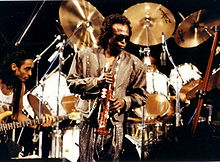
In the late 1960s and early 1970s the hybrid form of jazz-rock fusion was developed by combining jazz improvisation with rock rhythms, electric instruments and the highly amplified stage sound of rock musicians such as Jimi Hendrix. Jazz fusion music often uses mixed meters, odd time signatures, syncopation, complex chords and harmonies. All Music Guide states that "until around 1967, the worlds of jazz and rock were nearly completely separate. [However, ...] as rock became more creative and its musicianship improved, and as some in the jazz world became bored with hard bop and did not want to play strictly avant-garde music, the two different idioms began to trade ideas and occasionally combine forces."
Miles Davis' new directions
In 1969 Davis fully embraced the electric instrument approach to jazz with In a Silent Way, which can be considered his first fusion album. Composed of two side-long suites edited heavily by producer Teo Macero, this quiet, static album would be equally influential upon the development of ambient music. As Davis recalls: "The music I was really listening to in 1968 was James Brown, the great guitar player Jimi Hendrix, and a new group who had just come out with a hit record, "Dance to the Music," Sly and the Family Stone... I wanted to make it more like rock. When we recorded In a Silent Way I just threw out all the chord sheets and told everyone to play off of that." In a Silent Way featured contributions from musicians who would all go on to spread the fusion evangel with their own groups in the 1970s: Shorter, Hancock, Corea, pianist Josef Zawinul, John McLaughlin, Holland, and Williams. Williams quit Davis to form the group The Tony Williams Lifetime with McLaughlin and organist Larry Young. Their debut record of that year Emergency! is also cited as one of the early acclaimed fusion albums.
Psychedelic-jazz
Bitches Brew
Davis's Bitches Brew (1970) was his most successful of this era. Although inspired by rock and funk, Davis's fusion creations were original, and brought about a type of new avant-garde, electronic, psychedelic-jazz, as far from pop music as any other Davis work.
Herbie Hancock
Davis alumnus, pianist Herbie Hancock, released four albums of the short-lived (1970–1973) psychedelic-jazz sub-genre: Mwandishi (1972), Crossings (1973), and Sextant (1973). The rhythmic background was a mix of rock, funk, and African-type textures.
Musicians who worked with Davis formed the four most influential fusion groups: Weather Report and Mahavishnu Orchestra emerged in 1971 and were soon followed by Return to Forever and The Headhunters.
Weather Report
Weather Report's debut album was in the electronic, psychedelic-jazz vein. The self-titled Weather Report (1971) caused a sensation in the jazz world on its arrival, thanks to the pedigree of the group’s members (including percussionist Airto Moreira), and their unorthodox approach to their music. The album featured a softer sound than would be the case in later years (predominantly using acoustic bass, with Shorter exclusively playing soprano saxophone, and with no synthesizers involved) but is still considered a classic of early fusion. It built on the avant-garde experiments which Zawinul and Shorter had pioneered with Miles Davis on Bitches Brew (including an avoidance of head-and-chorus composition in favour of continuous rhythm and movement) but taking the music further. To emphasise the group's rejection of standard methodology, the album opened with the inscrutable avant-garde atmospheric piece "Milky Way" (created by Shorter's extremely muted saxophone inducing vibrations in Zawinul's piano strings while the latter pedalled the instrument). Down Beat described the album as "music beyond category" and awarded it Album of the Year in the magazine's polls that year. Weather Report's subsequent releases were creative funk-jazz works.
Jazz-rock
Although jazz purists protested the blend of jazz and rock, some of jazz's significant innovators crossed over from the contemporary hard bop scene into fusion. In addition to using the electric instruments of rock, such as the electric guitar, electric bass, electric piano and synthesizer keyboards, fusion also used the powerful amplification, "fuzz" pedals, wah-wah pedals, and other effects used by 1970s-era rock bands. Notable performers of jazz fusion included Miles Davis, keyboardists Joe Zawinul, Chick Corea, Herbie Hancock, vibraphonist Gary Burton, drummer Tony Williams, violinist Jean-Luc Ponty, guitarists Larry Coryell, Al Di Meola, John McLaughlin and Frank Zappa, saxophonist Wayne Shorter and bassists Jaco Pastorius and Stanley Clarke. Jazz fusion was also popular in Japan where the band Casiopea released over thirty fusion albums.
In the twenty-first century, almost all jazz has influences from other nations and styles of music, making jazz fusion as much a common practice as style.
Jazz-funk
Developed by the mid-1970s, jazz-funk is characterized by a strong back beat ( groove), electrified sounds, and often, the presence of electronic analog synthesizers. The integration of funk, soul and R&B music into jazz resulted in the creation of a genre whose spectrum is wide and ranges from strong jazz improvisation to soul, funk or disco with jazz arrangements, jazz riffs and jazz solos, and sometimes soul vocals.
Early examples are Herbie Hancock's Headhunters band and the Miles Davis album On the Corner. The latter, from 1972, began Miles Davis's foray into jazz-funk and was, Davis claimed, an attempt at reconnecting with the young black audience which had largely forsaken jazz for rock and funk. While there is a discernible rock and funk influence in the timbres of the instruments employed, other tonal and rhythmic textures, such as the Indian tambora and tablas, and Cuban congas and bongos, create a multi-layered soundscape. From a musical standpoint, the album was a culmination of sorts of the musique concrète approach that Davis and producer Teo Macero had begun to explore in the late 1960s.
At the jazz end of the spectrum, jazz-funk characteristics include a departure from ternary rhythm (near-triplet), i.e., the "swing", to the more danceable and unfamiliar binary rhythm, known as the " groove". Jazz-funk also draws influences from traditional African music, Afro-Cuban rhythms and Jamaican reggae, most notably Kingston band leader Sonny Bradshaw. A second characteristic of jazz-funk is the use of electric instruments. The ARP Odyssey, ARP String Ensemble and Hohner D6 Clavinet also became popular at the time. A third feature is the shift of proportions between composition and improvisation: arrangements, melody and overall writing were heavily emphasized.
Irakere and the emergence of the Cuban school
The first Cuban band of this new wave was Irakere (1973). "Chékere-son" (1976) introduced a style of "Cubanized" bebop-flavored horn lines, that departed from the more angular guajeo-based lines typical of Cuban popular music, and Latin jazz up until that time. It was based on Charlie Parker's bebop composition "Billie's Bounce". Almost all of "Billie's Bounce" can be found in "Chékere-son", but it is jumbled together in a way that fuses clave and bebop horn lines.
The horn line style introduced in "Chékere-son" is heard today in Afro-Cuban jazz, and the contemporary popular dance genre known as timba. Another important Irakere contribution is their use of batá and other Afro-Cuban folkloric drums. Ironically, several of the founding members did not always appreciate Irakere's fusion of jazz and Afro-Cuban elements. They saw the Cuban folk elements as a type of nationalistic "fig leaf", cover for their true love—jazz. In spite of the ambivalence by some members towards Irakere's Afro-Cuban folkloric/jazz fusion, their experiments forever changed Cuban jazz: their innovations are heard in the high level of harmonic and rhythmic complexity in Cuban jazz, and in the jazzy and complex contemporary form of popular dance music known as timba.
Other trends
Musicians began improvising jazz tunes on unusual instruments, such as the jazz harp ( Alice Coltrane), electrically amplified and wah-wah pedaled jazz violin ( Jean-Luc Ponty), and even bagpipes ( Rufus Harley). Jazz continued to expand and change, influenced by other types of music, such as world music, avant garde classical music, and rock and pop music. Guitarist John McLaughlin's Mahavishnu Orchestra played a mix of rock and jazz infused with East Indian influences. The ECM record label began in Germany in the 1970s with artists including Keith Jarrett, Paul Bley, the Pat Metheny Group, Jan Garbarek, Ralph Towner, Kenny Wheeler, John Taylor, John Surman and Eberhard Weber, establishing a new chamber music aesthetic, featuring mainly acoustic instruments, and sometimes incorporating elements of world music and folk music.
1980s
In 1987, the US House of Representatives and Senate passed a bill proposed by Democratic Representative John Conyers, Jr. to define jazz as a unique form of American music stating, among other things, "... that jazz is hereby designated as a rare and valuable national American treasure to which we should devote our attention, support and resources to make certain it is preserved, understood and promulgated." It passed in the House of Representatives on September 23, 1987 and in the Senate on November 4, 1987.
Resurgence of Traditionalism
While the 1970s had been dominated by the fusion and free jazz genres, the early 1980s saw a re-emergence of a more conventional kind of acoustic or straight-ahead jazz. Perhaps the most prominent manifestation of this resurgence was the emergence of trumpeter Wynton Marsalis, who strove to create music within what he believed was the tradition, rejecting both fusion and free jazz and creating extensions of the small and large forms initially pioneered by such artists as Louis Armstrong and Duke Ellington as well as the hard bop of the 1950s. Several musicians who had been prominent in the fusion genre during the 1970s began to record acoustic jazz once more, including Chick Corea and Herbie Hancock. Even the early-80s music of Miles Davis, although still recognisably fusion, adopted a far more conventional approach than his abstract work of the 1970s. A similar reaction took place against free jazz: according to Ted Giola,
the very leaders of the avant garde started to signal a retreat from the core principles of Free Jazz. Anthony Braxton began recording standards over familiar chord changes. Cecil Taylor played duets in concert with Mary Lou Williams, and let her set out structured harmonies and familiar jazz vocabulary under his blistering keyboard attack. And the next generation of progressive players would be even more accommodating, moving inside and outside the changes without thinking twice. Musicians such as David Murray or Don Pullen may have felt the call of free-form jazz, but they never forgot all the other ways one could play African-American music for fun and profit.
Smooth jazz
In the early 1980s, a commercial form of jazz fusion called pop fusion or "smooth jazz" became successful and garnered significant radio airplay. Smooth jazz saxophonists include Grover Washington, Jr., Kenny G, Kirk Whalum, Boney James and David Sanborn. Smooth jazz received frequent airplay with more straight-ahead jazz in " quiet storm" time slots at radio stations in urban markets across the U.S., helping to establish or bolster the careers of vocalists including Al Jarreau, Anita Baker, Chaka Khan and Sade. In this same time period Chaka Khan released Echoes of an Era, which featured Joe Henderson, Freddie Hubbard, Chick Corea, Stanley Clarke and Lenny White. She also released the song "And the Melody Still Lingers On (Night in Tunisia)" with Dizzy Gillespie reviving the solo break from " Night in Tunisia".
In general, smooth jazz is downtempo (the most widely played tracks are in the 90–105 BPM range), layering a lead, melody-playing instrument (saxophones—especially soprano and tenor—are the most popular, with legato electric guitar playing a close second). In his Newsweek article "The Problem With Jazz Criticism" Stanley Crouch considers Miles Davis' playing of fusion as a turning point that led to smooth jazz. In Aaron J. West's introduction to his analysis of smooth jazz, "Caught Between Jazz and Pop" he states,
I challenge the prevalent marginalization and malignment of smooth jazz in the standard jazz narrative. Furthermore, I question the assumption that smooth jazz is an unfortunate and unwelcomed evolutionary outcome of the jazz-fusion era. Instead, I argue that smooth jazz is a long-lived musical style that merits multi-disciplinary analyses of its origins, critical dialogues, performance practice, and reception.
Acid jazz, nu jazz and jazz rap
Acid jazz developed in the UK over the 1980s and 1990s, influenced by jazz-funk and electronic dance music. Jazz-funk musicians such as Roy Ayers and Donald Byrd are often credited as forerunners of acid jazz. While acid jazz often contains various types of electronic composition (sometimes including sampling or live DJ cutting and scratching), it is just as likely to be played live by musicians, who often showcase jazz interpretation as part of their performance. Nu jazz is influenced by jazz harmony and melodies; there are usually no improvisational aspects. It ranges from combining live instrumentation with beats of jazz house, exemplified by St Germain, Jazzanova and Fila Brazillia, to more band-based improvised jazz with electronic elements such as that of The Cinematic Orchestra, Kobol, and the Norwegian "future jazz" style pioneered by Bugge Wesseltoft, Jaga Jazzist, Nils Petter Molvær, and others. Nu jazz can be very experimental in nature and can vary widely in sound and concept.
Jazz rap developed in the late 1980s and early 1990s, and incorporates jazz influence into hip hop. In 1988, Gang Starr released the debut single "Words I Manifest", sampling Dizzy Gillespie's 1962 "Night in Tunisia", and Stetsasonic released "Talkin' All That Jazz", sampling Lonnie Liston Smith. Gang Starr's debut LP, No More Mr. Nice Guy ( Wild Pitch, 1989), and their track "Jazz Thing" ( CBS, 1990) for the soundtrack of Mo' Better Blues, sampling Charlie Parker and Ramsey Lewis. Gang Starr also collaborated with Branford Marsalis and Terence Blanchard.Groups making up the collective known as the Native Tongues Posse tended towards jazzy releases; these include the Jungle Brothers' debut Straight Out the Jungle (Warlock, 1988) and A Tribe Called Quest's People's Instinctive Travels and the Paths of Rhythm ( Jive, 1990) and The Low End Theory (Jive, 1991).
The Low End Theory has become one of hip hop's most acclaimed albums, and earned praise too from jazz bassist Ron Carter, who played double bass on one track. Rap duo Pete Rock & CL Smooth incorporated jazz influences on their 1992 debut Mecca and the Soul Brother. Beginning in 1993, rapper Guru's Jazzmatazz series used jazz musicians during the studio recordings. Though jazz rap had achieved little mainstream success, jazz legend Miles Davis' final album (released posthumously in 1992), Doo-Bop, was based around hip hop beats and collaborations with producer Easy Mo Bee. Davis' ex-bandmate Herbie Hancock returned to hip hop influences in the mid-nineties, releasing the album Dis Is Da Drum in 1994.
Punk jazz and jazzcore
The relaxation of orthodoxy concurrent with post-punk in London and New York City led to a new appreciation for jazz. In London, the Pop Group began to mix free jazz, along with dub reggae, into their brand of punk rock. In NYC, No Wave took direct inspiration from both free jazz and punk. Examples of this style include Lydia Lunch's Queen of Siam, the work of James Chance and the Contortions, who mixed Soul with free jazz and punk, Gray, and the Lounge Lizards, who were the first group to call themselves " punk jazz."
John Zorn began to make note of the emphasis on speed and dissonance that was becoming prevalent in punk rock and incorporated this into free jazz. This began in 1986 with the album Spy vs. Spy, a collection of Ornette Coleman tunes done in the contemporary thrashcore style. The same year, Sonny Sharrock, Peter Brötzmann, Bill Laswell, and Ronald Shannon Jackson recorded the first album under the name Last Exit, a similarly aggressive blend of thrash and free jazz. These developments are the origins of jazzcore, the fusion of free jazz with hardcore punk.
In the 1990s, punk jazz and jazzcore began to reflect the increasing awareness of elements of extreme metal (particularly thrash metal and death metal) in hardcore punk. A new style of "metallic jazzcore" was developed by Iceburn, from Salt Lake City, and Candiria, from New York City, though anticipated by Naked City and Pain Killer. This tendency also takes inspiration from jazz inflections in technical death metal, such as the work of Cynic and Atheist.
M-Base
The M-Base movement was started in the 1980s by a loose collective of young African-American musicians ( Steve Coleman, Graham Haynes, Cassandra Wilson, Geri Allen, Greg Osby etc.) who emerged in New York with a new sound and specific ideas about creative expression. With a strong foothold as well as in the tradition represented by Charlie Parker and John Coltrane as in contemporary African-American groove music and with a high degree of musical skills, the saxophonists Steve Coleman, Greg Osby, and Gary Thomas developed unique and complex, nevertheless grooving musical languages. In the 1990s most participants of the M-Base movement turned to more conventional music but Steve Coleman, the most active participant, continued developing his music in accordance with the M-Base concept.
In a long research process he developed a philosophical and spiritual concept connecting with certain cultural efforts that express fundamental aspects of nature and human existence in a holistic way. Steve Coleman found these efforts all over the world and they reach far back into ancient times. Thus, he gave his music a specific meaning which is similar to the intentions of religious music, of European composers like J.S. Bach and Ludwig van Beethoven, as well as of musicians in the tradition represented by John Coltrane. Coleman's audience decreased but his music and concepts influenced many musicians—both in terms of music-technique and of the music's meaning. Hence, "M-Base" changed from a movement of a loose collective of young musicians to a kind of informal Steve Coleman "school" with a much advanced but already originally implied concept.
1990s–2010s
Jazz since the 1990s has been characterised by a pluralism in which no one style dominates but rather a wide range of active styles and genres are popular. Often individual performers will record and play music in a variety of different styles, sometimes in the same performance. Musicians emerging since the 1990s and usually performing in more-or-less straight-ahead settings include US pianists Brad Mehldau, Jason Moran and Vijay Iyer, guitarist Kurt Rosenwinkel, vibraphonist Stefon Harris, trumpeters Roy Hargrove and Terence Blanchard, saxophonists Chris Potter and Joshua Redman and bassist Christian McBride.
Although jazz-rock fusion reached the height of its popularity in the 1970s, the use of electronic instruments and rock-derived musical elements in jazz continued in the 1990s and 2000s. Musicians using this approach have included Pat Metheny, John Abercrombie, John Scofield and Swedish group e.s.t. among others. Pianist Brad Mehldau and power trio The Bad Plus have explored contemporary rock music within the context of the traditional jazz acoustic piano trio, for example recording instrumental jazz versions of songs by rock musicians. The Bad Plus have also incorporated elements of free jazz into their music. A number of new vocalists have achieved popularity with a mix of traditional jazz and pop/rock forms, such as Diana Krall, Norah Jones, Cassandra Wilson, Kurt Elling and Jamie Cullum.
While some musicians such as saxophonists Greg Osby and Charles Gayle have maintained a firm avant-garde or free jazz stance, others such as James Carter have incorporated free jazz elements into a more traditional framework. Established musicians in a variety of styles continued to perform, such as Wayne Shorter, Herbie Hancock, Chick Corea, Sonny Rollins, Wynton Marsalis, Keith Jarrett, David Murray and McCoy Tyner.
